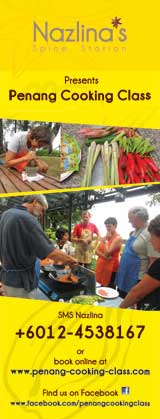
|
||
|
Follow @Nazlina
More About CinnamonMalay Spices - Cinnamon (Kayu Manis)This page covers more about cinnamon, the spice you always found in desserts and curries.
Cinnamon comes from the bark of the cinnamon trees. In Malay spices vocabulary, it is called "kayu manis" literally meaning sweet wood. The cinnamon that we normally see at grocery stores and that we use daily usually comes from cassia tree. This is much cheaper than the true cinnamon which originates from Sri Lanka (Ceylon). The flavor of true cinnamon is more subtle and delicate compared to the stronger, spicier cassia. The light, intricate flavor of Ceylon cinnamon makes it the cinnamon of choice for dishes which do not have a lot of conflicting flavors competing. It will star in such dishes as custard, cinnamon ice cream, Dutch pears, stewed rhubarb, steamed puddings, dessert syrups, or mixed into whipped cream. Both substances we call cinnamon come from the inner bark of trees that have historically been cultivated in southeast Asia. The first substance is made from the tree known as Cinnamomum verum (also called "Ceylon cinnamon", "cinnamomum zeylanicum" or "true cinnamon"). Its medicinal properties include a mild antifungal and antibacterial effect. The second substance we call cinnamon comes from the bark of a related tree, Cinnamomum aromaticum, often called "Chinese cinnamon", "false cinnamon" or "cassia cinnamon". Because true cinnamon is more expensive to obtain, most of the cinnamon sold in stores today is cassia cinnamon, or a blend of true and cassia cinnamons. (Some people say you can identify sticks of true cinnamon by looking at the way they roll. True cinnamon tends to form a single tube whereas cassia cinnamon rolls from both sides toward the middle). The two barks when whole are easily distinguished, and their microscopic characteristics are also quite distinct. True cinnamon sticks (or quills) have many thin layers and can easily be made into powder using a coffee or spice grinder whereas cassia sticks are much harder, made up of one thick layer, capable of damaging a spice or coffee grinder. In Malay spices, cinnamon (actually cassia cinnamon) are used as sticks, thrown in the curry, or any dishes you are making. I normally use my pestle and mortar to break small amounts of these quills in my cooking. A little bit goes a long way. I use it to add flavor to nasi lemak and also when I make my briyani rice. This is true for Malay spices, you only need a small amount to flavor the food. Discard cinnamon sticks just before serving. I can write more about cinnamon, but it may be too much for an average cooking enthusiasts. So, let's start cooking! Back to the page of Malay Spices Back to my list of pickles and spices recipes

Custom Search
|

Custom Search
Nazlina's Cooking Class in PenangAttend my cooking class to learn making traditional food.
The morning class includes Penang Market Tour.
PLEASE NOTE: We now offer PM classes, for vegan and vegetarians. |
|
|
|
||
|
|
||



New! Comments
Have your say about what you just read! Leave me a comment in the box below.